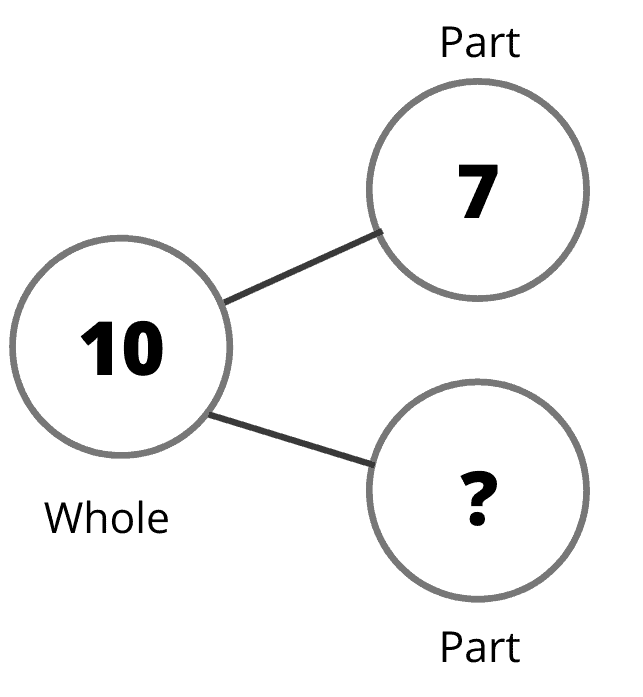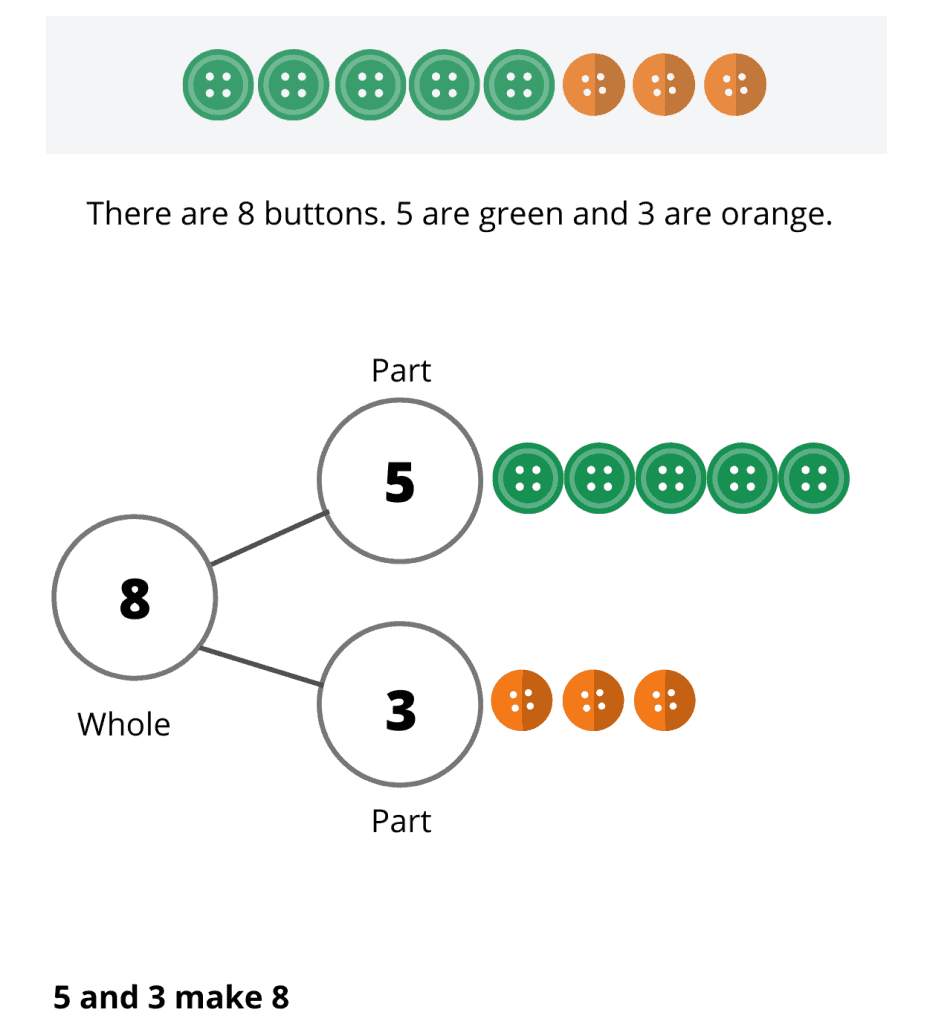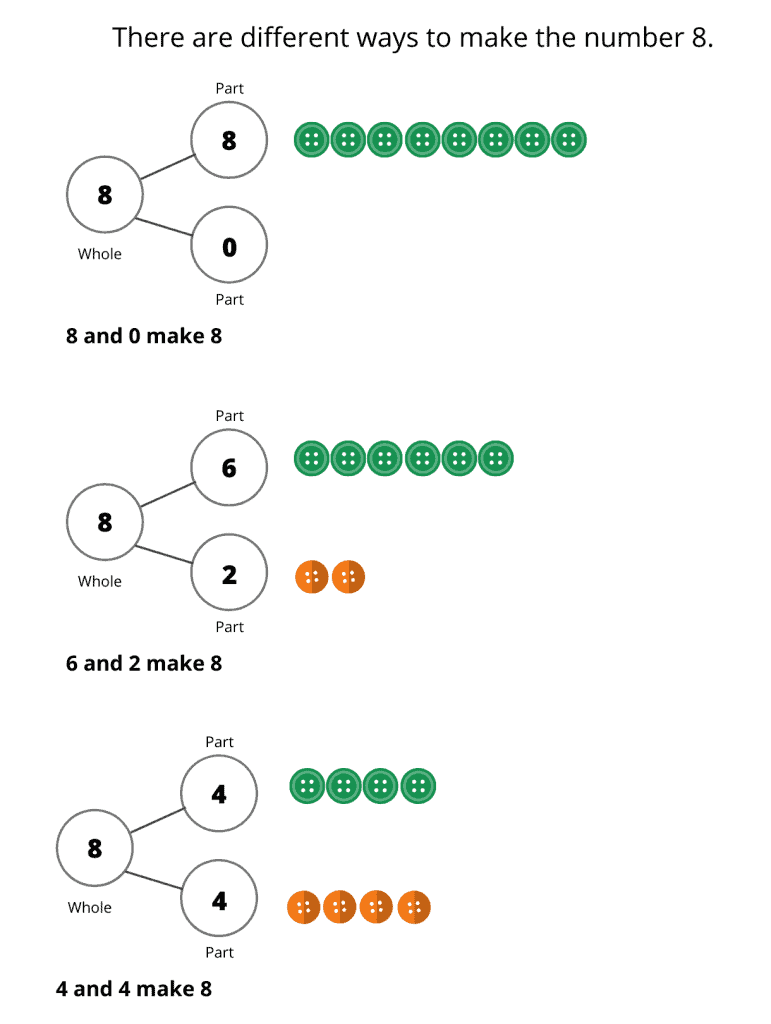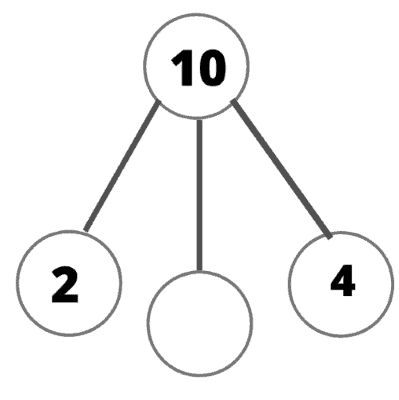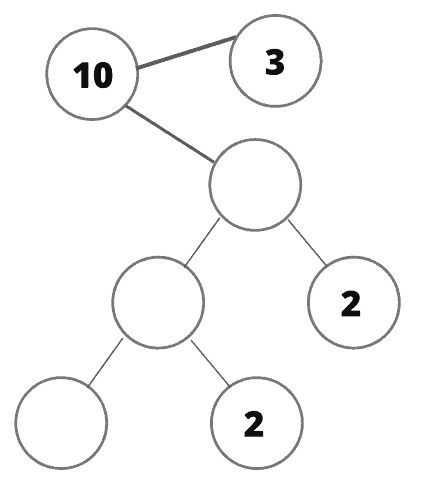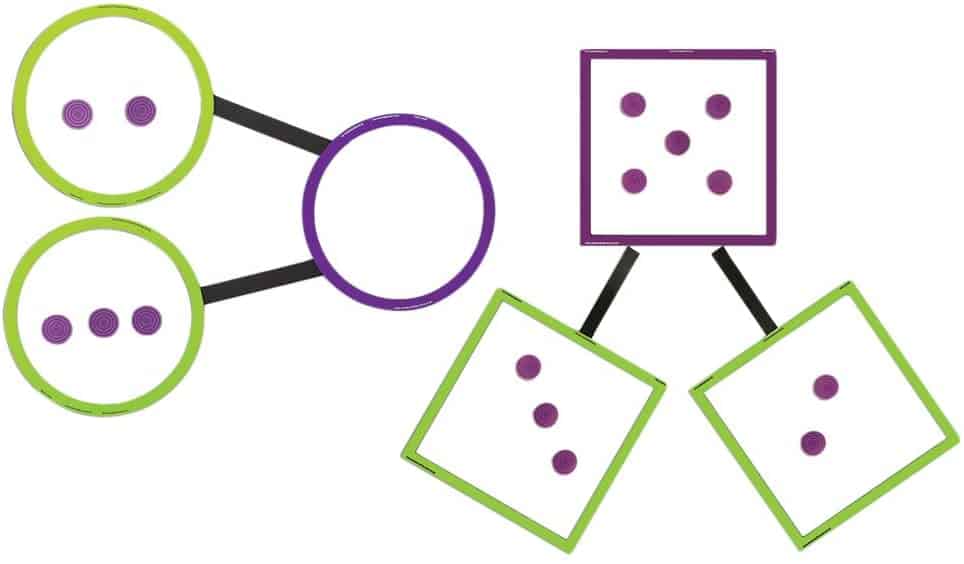Number bonds are a great tool to use to build number sense, mental math, and teach addition and subtraction. Number bonds also help students see the ‘part-whole’ relationship of numbers that is an essential strategy in Singapore Math.
What are Number Bonds?
Number bonds are collections of numbers that can be added together to form a whole. It can be a useful tool to determine an answer without actual calculation or writing an equation.
The term number bond is also used to refer to a graphical depiction of part-part-whole relationships. The “whole” is written in the first circle and its “parts” are written in the adjacent circles.
A number bond represents the relationship between a quantity and the parts that combine to make it. The idea of number bonds is very fundamental, an understanding of the way numbers work. It is made up of parts and if you know the parts, you can put them together (add) to find the whole. If you see the whole and one of the parts is unknown, you remove the part you know (subtract) from the whole to find the other part. A child learning that 3 add 7 equals 10 is also learning that 10 minus 7 equals 3 and that 10 minus 3 equals 7. It let children see the inverse association between addition and subtraction. To subtract means to figure out how much more you would have to add to get the whole. A child who understands this number bond will be able to instantaneously fill in any one of these three numbers if it was omitted, given the other two, without having to “work it out”.
In the example below, we can see the relationship between part and whole numbers and that 5 and 3 make 8.
Next, we can teach students that there are different ways to make the number 8. We can see that 8 and 0 make 8, 6 and 2 make 8 or that 4 and 4 make 8.
Number Bond in Kindergarten/ Pre-school
When used in preschool or kindergarten, number bonds develop number sense and set a foundation to move on to addition and subtraction and mental math. It can help children gain insight into how numbers work and help us to understand that a whole number is made up of parts. Number bonds are also an excellent preamble to the fact that subtraction is the reverse of addition. As students go on to higher grades, number bonds become an important mental problem-solving strategy.
The components of a number bond consist of circles connected by lines. A number bond contains at least 3 circles that are linked by lines. However, you can also build more complex number bonds like the ones below:
Benefits of Number Bonds.
Number bonds help develop a student’s number sense and mental math. As we can see from the above examples, It helps students see that numbers can be “broken” into parts to make calculation easier. With number bonds, students distinguish the relationships between numbers through a visual model that shows how the numbers are related. A number bond helps students clearly see the Part/Whole relationship. The circles or squares are just a pictorial representation that students should begin with. By first grade, some students may move away from the shape visual. This enables children to be able to do mental arithmetic.
Number Bond to 10
Number bonds are frequently learned in sets for which the sum is a common round number such as 10. Learning it to 10 is important for mental mathematics, as this links into place value and the base 10 number structure.
Knowing numbers bonds with confidence allows children to develop strategies for solving more complicated mental problems. As a simple example, to carry out the calculation 8 + 5 mentally, a child who can instantly remember their number bonds to 10 and will identify that they need to add 8 to 2 to get up to 10. They then have 3 left over from the 5 and can now add that on to the 10 to make 13. Essentially, they are breaking the addition up into (8+ 2) + 3 = 10 + 3 = 13.
Learning number bonds can also benefit students as they progress to higher grade levels. The example below shows how a student would use number bonds to perform a mental calculation with larger numbers.

How To Teach Number Bonds To Your Child.
There are numerous ways to teach number bonds to a child.
One way to introduce kids to number bonds is by using the Concrete to Pictorial to Abstract approach.
At the concrete stage, students use manipulatives and objects such as counters or real-life objects to learn. At the pictorial stage, kids can progress to writing it on whiteboards or paper. As learning progresses to the abstract stage, a student can start representing it a mathematical notation (4+ 5 = 9).
Below are some activities that can be used to teach your child number bonds.
Exploring the Part and Whole Relationship
Since number bonds are used to help children recognize the relationship between a whole number and its parts, it is best to begin by exploring this part-whole relationship. Food (cheerios, gummy bears) works great for this! You can sort food into “whole” and “part” groups.
Explore the Number Bond Pictures.
Once a child is able to comprehend the meanings of the words “part” and “whole,” you can introduce number bond pictorial or use number bond templates. You then challenge the child to spot the “whole” circle and the “part” circles.
Display the pictorial or template in different directions as it is displayed in different ways.
Construct a Number Bond
You can use paper plates and straws but get innovative and use what you have on hand! Make sure the child constructs it in all directions and ask him/her to lay a hand on the whole and parts when named.
Sketch a Number Bond
Although It is usually made with circles, other shapes like squares, triangles, stars, and rectangles can also be used.
Invite the child to draw it in all directions using shapes of his/her choosing.
Worksheets
Using worksheets/ printables is also a great way to practice and master number bonds once the child is able to write.
Resources
Learning Resources Giant Magnetic Number Bonds
Didax 211011 Educational Resources Write-On Wipe-Off Five and Ten-Frame Mats
Disclosure: This post might contain affiliate links and SingaporeMathLearningCenter.Com is a participant in the Amazon Associates program and may earn a small commission from qualifying purchases.


